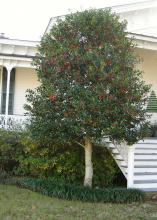Information Possibly Outdated
The information presented on this page was originally released on January 14, 2010. It may not be outdated, but please search our site for more current information. If you plan to quote or reference this information in a publication, please check with the Extension specialist or author before proceeding.
Hollies provide great winter berry, leaf color
Numerous landscape plants have attractive foliage mixed with colorful berries, but few can match the brilliant luster of a holly.
The striking, dark green leaves of hollies provide a beautiful backdrop for their deep red and orange berries. Another reason these plants are so popular in the landscape is their ability to adapt to environmental conditions.
When hollies come to mind, many gardeners only think of evergreen hollies, but there are some outstanding deciduous selections, as well. A well-known deciduous holly with grayish stems and deep red berries is Possumhaw. It can grow 10 feet tall and wide, so allow ample room for growth. Two popular varieties are Warren’s Red and Byers Golden.
A second deciduous holly is Common Winterberry, which has dark red fruit and a compact, versatile growth habit. The stems are dark gray to brown, and this holly grows 6 to 10 feet high and wide. It needs a male pollinator to produce berries, so be sure to purchase one if not already present in your landscape. Two popular varieties are Winter Red and Red Sprite.
Evergreen hollies are some of the more spectacular plants in our gardens. Two of the more popular large varieties are Foster Holly and American Holly.
American Holly grows the tallest, reaching heights of 40 to 50 feet. It has a dense, pyramidal growth habit with 2- to 4-inch-long, medium green leaves, and it produces attractive red fruit. Popular named varieties include Cardinal, Carolina 2, Croonenburg and Jersey Princess.
Foster Holly grows only to a height of 20 to 30 feet but is just as striking. Its shape is similar to a cone or pyramid, and it has dark green leaves that are 1 to 3 inches long. The most common variety you’ll find is Foster’s #2.
If you need a smaller holly for your landscape, there are many excellent varieties to choose from. Blue Girl and Blue Princess are Meserveae Hybrid Holly cultivars that have blue-green, leathery leaves and grow to around 10 feet high. China Girl has outstanding, dark red fruit, and Golden Girl has beautiful, golden fruit that provides a striking landscape contrast.
Other popular hollies are Dwarf Burford, Needlepoint, Nellie R. Stevens and Mary Nell. All of these hold their abundant fruit through the dreary winter months, and they look amazing while doing so.
Most hollies prefer to grow in full to partial sun in acidic, well-drained soil. They perform excellently throughout Mississippi and look their best when planted in masses. Most have berry color from September or October until spring.
Hollies’ only real insect concerns come from scale and leaf-miners, and if you plant yours in well-drained soil, you shouldn’t have any problems with root rot.
Hollies are beautiful, tough and a plus for any garden, so don’t hesitate to use any variety. Mary Nell is my personal favorite of the evergreen hollies, and Winterberry is my favorite among the deciduous hollies, but they all have a place in any Southern garden.








